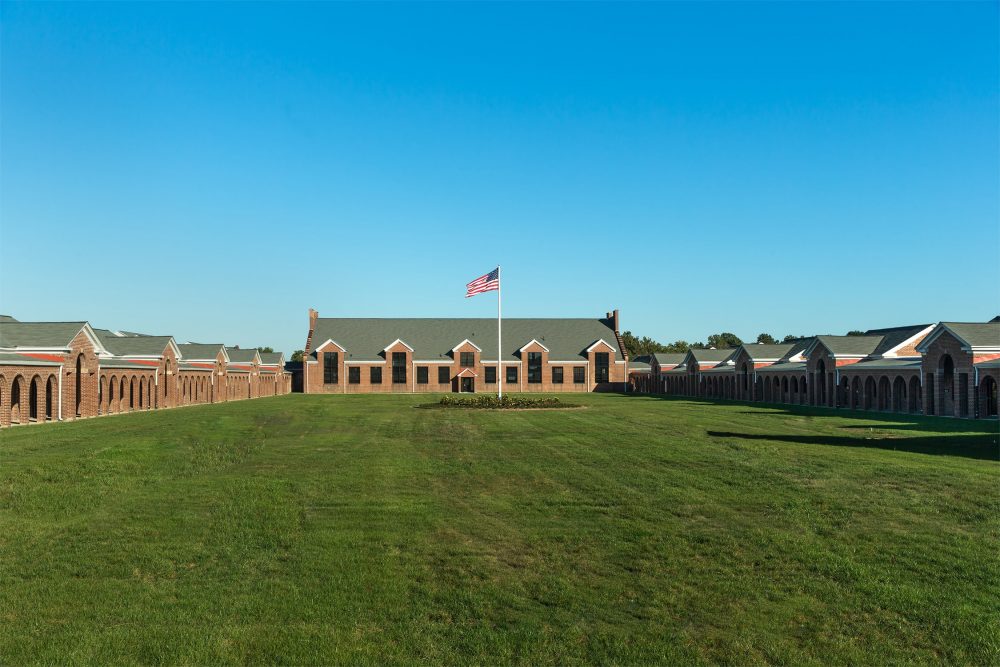The last prisoner at Lorton Reformatory was transferred away in 2001. In 16 months, the aged red brick walls that once housed criminals in the hopes of rehabilitating them through various work projects could be housing people on the other side of the penal system.
On Dec. 7, elected officials, government staff, developers and involved citizens broke ground on a two-phase redevelopment project for the 80-acre Laurel Hill Adaptive Reuse area, estimated at $188 million.
“This will be the gem that sits in the crown we’ve placed on the head of Laurel Hill,” said Supervisor Gerry Hyland (D-Mount Vernon).
After the last prisoner left, Fairfax County purchased the reformatory structures and land, roughly 2,300 acres, from the Washington, D.C. Department of Corrections. President Theodore Roosevelt had originally commissioned the prison be built, early in the 20th century.
“This was a brave experiment for ‘compassionate rehabilitation,’” Board of Supervisors Chairman Sharon Bulova said of the prison’s fresh-air and manual labor program for inmates. Fairfax County immediately began looking at redevelopment opportunities, including calling together a citizens advisory committee to discuss suggestions.
With other parcels of the Laurel Hill moving forward for redevelopment as a golf course, middle and high school, residential communities and an arts center, the compound being featured on Dec. 7 was seen as a mixed-use village for residential, retail and other community space. It’s being called “Liberty Crest at Laurel Hill.”
“Fourteen years of planning and preparation, and now it’s the final piece of the puzzle,” Bulova said. “This new community will preserve the historic character of the site. We’re excited for it to become a vibrant walkable community where people can dine, shop, be close to arts. Where they’ll live, work, play and thrive in Fairfax County.”
THE FIRST PHASE of redevelopment calls for both reuse of existing structures for 165 apartments and new construction of 107 new homes, as well as infrastructure build-up. A second phase includes adding townhomes and condos in both reformatory and new buildings, as well as 110,000 square feet of retail space.
Bulova introduced U.S. Rep. Gerry Connolly (D-11) who previously held the Board of Supervisors Chairman position and “had the vision for repurposing and revitalizing” the areas of Lorton, she said.
“How transformed this corner of the world is,” Connolly said. Connolly praised Supervisor Gerry Hyland (D-Mount Vernon) for his role in bringing the project forward, as well.
“It was his tenacity, his vision, to continue until he got his ‘Yes,’” he said.
“Today is all about an idea,” Connolly continued. “Lorton was not an address you wanted. [The prison] was a fetid, prisoner-controlled, dangerous place that had long since lost its reformative, liberal, reputation. It was an eyesore for our community.”
Breaking apart the 2,300 acres into smaller, more manageable slices to redevelop was an effective way to make Lorton “a community asset,” Connolly said. “Today we celebrate another piece of that.”
With McLean-based Elm Street and The Alexander Company out of Madison, Wis. on board, Fairfax County’s contribution to site infrastructure costs is capped at $13 million.
Fred Selden, director of Fairfax County Planning and Zoning, praised that public-private partnership for bringing the project forward. “Without it, none of this would’ve happened,” he said. “It will truly be a magnificent end result.”
Joseph Alexander, president of The Alexander Company, said “I look forward to you moving in in in 16 months.”

